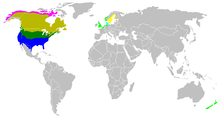Cackling Goose
| Cackling goose | |
|---|---|
 |
|
| Aleutian cackling goose Branta hutchinsii leucopareia |
|
| Scientific classification | |
| Kingdom: | Animalia |
| Phylum: | Chordata |
| Class: | Aves |
| Order: | Anseriformes |
| Family: | Anatidae |
| Subfamily: | Anserinae |
| Tribe: | Anserini |
| Genus: | Branta |
| Species: | B. hutchinsii |
| Binomial name | |
|
Branta hutchinsii (Richardson, 1832) |
|
| Subspecies | |
|
|
 |
|
| Cackling goose summer range | |
| Synonyms | |
|
Branta canadensis hutchinsii |
|
Branta canadensis hutchinsii
The cackling goose (Branta hutchinsii) is a North American bird of the genus Branta of black geese, which contains species with largely black plumage, distinguishing them from the grey Anser species.
The black head and neck with white "chinstrap" distinguish this goose from all other geese except the larger Canada goose (Branta canadensis) and the similarly sized barnacle goose (B. leucopsis). There are up to 5 subspecies of cackling goose, of varying sizes and plumage details. The female looks virtually identical but is slightly lighter and has a different voice. Some are hard to distinguish from the Canada goose, with which the cackling goose was long assumed to form one species, the cackling goose and the smaller Canada goose subspecies being called the lesser Canada goose. The smallest 1.4 kg (3.1 lb) Cackling geese (B. h. minima) are much smaller than any Canada goose, but the subspecies B. h. hutchinsii, at up to 3 kg (6.6 lb), grows to the same size as some Canada geese. The distinctness of the extinct population of the Komandorski and Kuril Islands B. h. asiatica is controversial. The barnacle goose differs in having a black breast and grey, rather than brownish, body plumage.
This species is native to North America. It breeds in northern Canada and Alaska in a variety of tundra habitats. However, the nest is usually located in an elevated area near water. The eggs are laid in a shallow depression lined with plant material and down. Males can be very aggressive in defending territory. A pair may mate for life (up to around 20 years). Adult geese are often seen leading their goslings in a line with one parent at the front, and the other at the back of the "parade".
Like most geese, it is naturally migratory, the wintering range being most of the U.S., and locally in western Canada and northern Mexico. The calls overhead from large groups of cackling geese flying in V-shaped formation signal the transitions into spring and fall. In some areas, migration routes have changed due to changes in habitat and food sources.
...
Wikipedia

